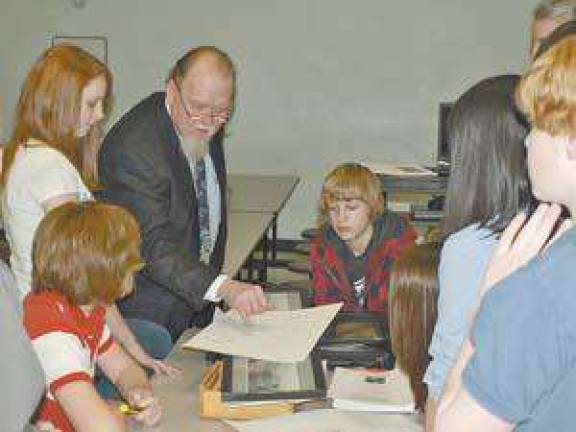History is a strong draw for Ogdensburg students

Ogdensburg You won’t see a sign reading Thomas Edison slept here. But he lost $2 million here approximately 100 years ago. Author Rodney P. Johnson of Highland Lakes came to Ogdensburg School last week to discuss the quirky history of Edison’s iron mines with students and members of the historical society. “I first became interested in the Edison operation on Sparta Mountain about 10 years ago,” said Johnson. “Over the years I was encouraged by the Hauck brothers of the Sterling Hill Mining Museum.” Johnson’s book “Thomas Edison’s Ogden Baby’” was written over a period of nearly five years. At the Ogdensburg school, Johnson showed the students a power point slide show that described his investigations both on top of Sparta Mountain and at various archives and historical societies. This work lead to the creation of an accurate map of the former mine and its production site on Edison Road. “Edison’s inventions were supposed to keep the labor force to a minimum,” Johnson told the group. “He boasted that it would only take five people to run the entire process. In reality 400 to 430 people were employed at the site,” said Johnson. If everything ran like clockwork it did take just a handful of people to throw the ore containing rocks into one end of the process and get iron ore briquettes out the other end. Maintenance and running improvements to the site took a much larger group of people. Johnson pointed out that many photographs of the site and especially of the patented machines used in the concentrating process were taken before the plant opened for business. Edison was secretive about the site; the only time he opened it to the public was for tours aimed at investors in his quest for financial backing. “Everything in the photos is spotless,” Johnson points out. “After the plant started running everything was soon covered in a layer of dust.” The dust must have been terrible as the plant could crush and process 6,000 tons of rock a day. “It looked like snow covering everything,” said the author. A short-lived project Before any profit could be made from the process, a cheaper source of iron ore was discovered out West. That signalled the end for Edison’s Ogdensburg project. Being $2 million in the red, Edison bailed out quickly once his Western competitors undercut his price for iron ore. The plant was only in existence from 1891 to 1900. But he cut his losses by sales of inventions related to mining and the sale of sand, a by-product of the iron ore separating process. “Locomotives and trolley cars used sand under the wheels for traction. Iron wheels on smooth rails required some help to get a grip. Beach sand is not very effective as it has been rounded off by tumbling in the surf,” explained Johnson. “The Edison sand still had the sharp corners intact.” While many connect Edison with the lightbulb and the phonograph, his inventions at the Ogdensburg site were strictly business-related. They included conveyor and bucket belts to endlessly move materials from one part of the plant to another and the magnetic-based processes used to separate the iron from the waste rock. Ogdensburg students using Johnson’s book as they research various projects and while he was in the classroom, a few had him review their computer-lab projects. Julianna Alfonso and Samantha McCurry ran their Power Point projects covering the life and inventions of Edison. A team of sixth-graders is working on a magnetic separator based on Edison’s process. Visit the site The Edison mine site can be found by turning onto Edison Avenue from Main Street in Ogdensburg. Go about 2 miles and you’ll find a small gravel parking lot on the left hand side. (The road changes name to Edison Road as it crosses into Sparta.) Fun facts The $2 million Edison spent in about 1900 would be approximately $59 million today. 400 to 430 employees could produce one hockey puck shaped briquette of iron ore per second, measuring 2.5 or 3 inches in diameter depending on customer preference.